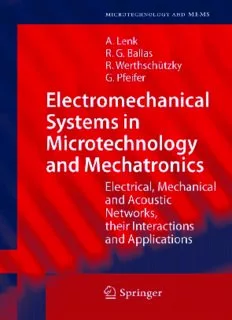Table Of Contentmicrotechnology and mems
microtechnology and mems
SeriesEditor:H.Fujita D.Liepmann
TheseriesMicrotechnologyandMEMScomprisestextbooks,monographs,and
state-of-the-art reports in the very active field of microsystems and microtech-
nology.Writtenbyleadingphysicistsandengineers,thebooksdescribethebasic
science, device design, and applications. They will appeal to researchers, engi-
neers,andadvancedstudents.
PleaseviewavailabletitlesinMicrotechnologyandMems
onserieshomepagehttp://www.springer.com/series/4526
Arno Lenk
Rüdiger G. Ballas
Roland Werthschützky
Günther Pfeifer
Electromechanical Systems
in Microtechnology and
Mechatronics
Electrical, Mechanical and Acoustic
Networks, their Interactions and
Applications
With313Figures
123
ProfessorDr.-InghabilArnoLenk Dr.-IngRüdigerG.Ballas
DresdenUniversityofTechnology KarlMayer
FacultyofElectricalandComputerEngineering TextileMachinery
Helmholtzstraße10 Bruehlstr.25
01069Dresden 63179Obertshausen
Germany Germany
[email protected]
ProfessorDr.-InghabilRolandWerthschützky ProfessorDr.-InghabilGüntherPfeifer
DarmstadtUniversityofTechnology DresdenUniversityofTechnology
InstituteforElectromechanicalDesign FacultyofElectricaland
Merckstr.25 ComputerEngineering
64283Darmstadt Helmholtzstraße10
Germany 01069Dresden
[email protected] Germany
ISSN1615-8326
ISBN978-3-642-10805-1 e-ISBN978-3-642-10806-8
DOI10.1007/978-3-642-10806-8
SpringerHeidelbergDordrechtLondonNewYork
LibraryofCongressControlNumber:2010936071
(cid:2)c Springer-VerlagBerlinHeidelberg2011
Thisworkissubjecttocopyright.Allrightsarereserved,whetherthewholeorpartofthematerial
isconcerned,specificallytherightsoftranslation,reprinting,reuseofillustrations,recitation,broad-
casting,reproductiononmicrofilmorinanyotherway,andstorageindatabanks.Duplicationof
thispublicationorpartsthereofispermittedonlyundertheprovisionsoftheGermanCopyrightLaw
ofSeptember9,1965,initscurrentversion,andpermissionforusemustalwaysbeobtainedfrom
Springer.ViolationsareliabletoprosecutionundertheGermanCopyrightLaw.
Theuseofgeneraldescriptivenames,registerednames,trademarks,etc.inthispublicationdoesnot
imply,evenintheabsenceofaspecificstatement,thatsuchnamesareexemptfromtherelevantpro-
tectivelawsandregulationsandthereforefreeforgeneraluse.
Coverdesign:WMXDesignGmbH,Heidelberg
Printedonacid-freepaper
SpringerispartofSpringerScience+BusinessMedia(www.springer.com)
Preface
Within the wide field of technical information processing, electromechanical
systems consisting of coupled electrical and mechanical functional elements
have a significant importance. Both the design of interfaces between human
and information processing mechanisms and the design of interfaces with the
materialprocessduringmetrologicaldataacquisitionandactuatoryinfluence
of process variables is made possible by these electromechanical systems. Ex-
amples for realization of electromechanical systems in the form of devices,
assemblies or components are:
peripheral devices of data processing systems like printers, scanners, disk
•
drives and data memories,
electroacousticdeviceslikeloudspeakers,microphonesandultrasonictrans-
•
ducers,
sensors for medicine, automotive and process measurement engineering,
•
actuators in the form of small drives and precision positioning systems.
•
The list mentioned above is increasingly extended by direct coupled sensor-
actuator-systemswithintegrateddataprocessing.Thus,theresultisasmooth
transition to more complex electromechanical systems of mechatronics.
The production of electromechanical systems results from enhanced preci-
sion engineering methods and modern technologies of microtechnology and
microsystems technology. In addition, used materials like high-grade steels,
ceramics, glasses, silicon and quartz, are subjected to continuous further de-
velopment.
In the phase of industrial development of electromechanical systems, the de-
sign process based on a solution concept provides a fundamental stage. Here,
geometrical, electrical and technological system parameters are defined being
vi Preface
based on a physical model considering special design criteria and technologi-
callimitations.Thecloseddynamicdesignoftheoverallsystemismademore
difficult by different subsystems consisting of electronic, mechanical, acoustic
and fluid elements.
The main objective of this book is the obtaining of a physically clear design
method for complex electromechanical systems. This design method is based
on the network theory, electrical engineers and engineers of information tech-
nology are familiar with. The total electromechanical system is described in
theformof a common technical circuit representation ofdifferent subsystems
including their interactions by means of network theory. Clear physical func-
tions are assigned to either lumped or distributed elements of the network.
The advantages of this design method are the application of clear analytical
methodsofelectricalnetworks,thepossibilityofthecloseddesignofphysically
different subsystems and the use of existing circuit simulation software. The
structuring of electromechanical systems according to electrical, mechanical
andacousticelementarynetworksandtheintroductionofpassivetransducers
as two-port networks which describe the loss-free linear interactions between
thesubsystems,arethefundamentalconditionsfortheapplicationofnetwork
theory.
The main features of this book are based on the structure-oriented theory
of electromechanical systems developed by Arno Lenk in the 60s to 90s. The
resultsweresummarizedinthebooks ElektromechanischeSysteme—Systeme
”
mit konzentrierten Parametern” [1], Elektromechanische Systeme — Systeme
”
mit verteilten Parametern” [2] and Elektromechanische Systeme — Systeme
”
mit Hilfsenergie” [3] which were published in the 70s in the Verlag Technik.
Thebookissuitableforstudentsofinformationtechnology,measurementand
automationengineering,mechatronics,technicalacousticsaswellasmicrosys-
tems technology and precision engineering. The book enables the electrical
engineer being familiar with network theory to get started quickly with the
solution of many dynamic problems concerning the design of coupled elec-
trical, mechanical, acoustic and fluid systems. In addition, this book is also
suitableformechanicalengineersinordertogetstartedwiththeefficientand
practice-orienteddesignmethodformechatronicsystems.Thenecessarybasic
knowledge of network theory is summarized in an extra chapter.
We gratefully acknowledge Stephan Sindlinger, Stefan Leschka, Eric Starke
and Uwe Marschner, whose current research results are presented in the sec-
tions concerning the finite network elements (Leschka, Sect. 6.3.1 and Sin-
dlinger, Sect. 6.3.2), the combination of FEA and network theory (Starke,
Sect. 6.4)and theapplication ofelectrodynamicandpiezomagneticactuators
(Marschner, Sect. 8.1.2, Sect. 8.3.3 and Sect. 8.3.4).
Preface vii
Finally, our thanks go to Eva Hestermann-Beyerle and Birgit Kollmar-Thoni
of Springer-Verlag, who offered an excellent cooperation and continuous sup-
port while we were writing this book.
Dresden and Darmstadt, July 2010
Arno Lenk, Ru¨diger G. Ballas, Roland Werthschu¨tzky, Gu¨nther Pfeifer
Contents
List of Symbols ................................................ xv
Part I Focus of the Book
1 Introduction .............................................. 3
1.1 Focus of the Book ...................................... 4
1.2 Fields of Application and Examples for Electromechanical
Systems ............................................... 6
1.3 Design of Electromechanical Systems ...................... 9
1.4 Simulation Methods for Electromechanical Systems ......... 10
1.4.1 Historical Overview................................ 10
1.4.2 Design Methods................................... 13
2 Electromechanical Networks and Interactions ............. 15
2.1 Signal Description and Signal Transmission in Linear
Networks .............................................. 16
2.1.1 The Circular Function as Basic Module for Time
Functions of Linear Networks ...................... 16
2.1.2 Fourier Expansion of Time Functions ................ 20
2.1.3 The Fourier Transform ............................ 25
2.1.4 The Laplace Transform ............................ 33
2.2 Electrical Networks ..................................... 36
2.3 Mechanical Networks .................................... 40
2.4 Interactions ............................................ 44
2.4.1 Mechanical Interactions ........................... 44
2.4.2 Electromechanical Interactions ..................... 46
2.5 Structured Network Representation of Linear Dynamic
Systems ............................................... 56
2.6 Basic Equations of Linear Networks ....................... 58
Description:Electromechanical systems consisting of electrical, mechanical and acoustic subsystems are of special importance in various technical fields, e.g. precision device engineering, sensor and actuator technology, electroacoustics and medical engineering. Based on a circuit-oriented representation, provi

